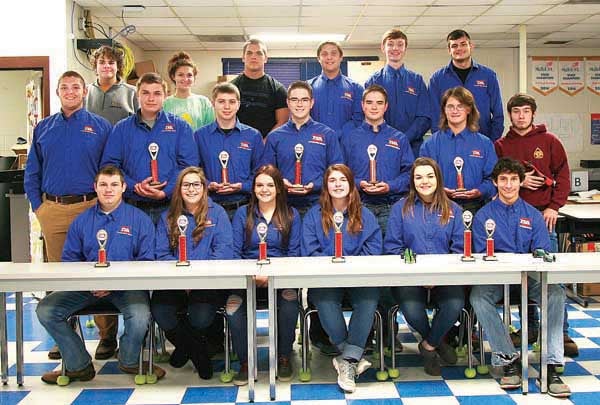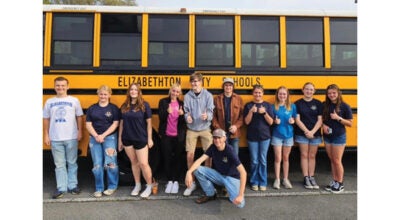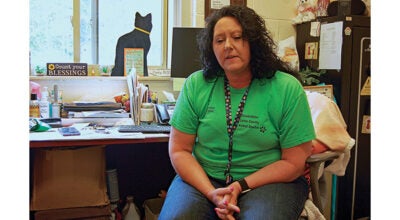Hampton students capture 11 honors at technology competition
Published 7:02 am Saturday, December 3, 2016

Star Photo/Abby Morris-Frye
Members of Hampton High School’s chapter of the Technology Student Association recently took part in t he TSA Regional Competition. Eleven of the students brought home placements in their individual competitions.
Students at Hampton High School are no strangers to academic success, a point recently demonstrated by members of the school’s Technology Student Association.
A total of 21 students in Hampton’s TSA chapter recently competed in the TSA Regional Competition with more than half of them placing in their individual events.
“That’s the most we ever had participate,” said Daniel Arnett, the school’s drafting teacher and TSA chapter sponsor. “We had 11 that placed.”
Arnett also praised his teacher colleagues Bruce Wiltshire, Patrick Kelly, and Tracy Shelton for their support and assistance with the students in getting them ready for competition. Kelly and Shelton assisted the students whose competitive events included presentations, speeches, photography and music production. Wiltshire, the school’s automotive teacher, assisted students competing in the dragster design event.
In the Computer Aided Drafting (CAD) Architecture competition, HHS senior Ian Kelly captured first place honors while junior Cody Vines brought home second place.
“We had to draw a mobile home made out of a shipping container,” Kelly said.
“It had to be able to be shipped on the bed of a flatbed truck,” Vines added.
Before walking into the contest, neither Kelly nor Vines knew what their challenge would be.
“We find out when we get in there and they give us two hours to do it,” Kelly said.
The students also had to follow certain guidelines in the creation of their shipping container homes. It had to feature at least one bedroom, one bathroom, a full kitchen, a living room and laundry facilities. Adding a deck was optional, but it had to be detachable so it could be shipped with the home.
“We had to keep it below a certain height so it would fit under bridges,” Kelly said. We had to meet energy standards to try to make the home an energy efficient home.”
In the CAD Engineering contest, senior Ryan Kelly (twin brother to Ian) captured first place and sophomore Zach Oliver brought home second place.
“We had to draw a machine to roll up rolls of vinyl used to cover up a gym floor for special occasions,” Ryan Kelly said.
As with the architecture contest, neither of the students knew what the challenge would be in advance and had two hours to complete their design. They also had certain size specifications they had to follow.
“I made a manual roller that just sat up on legs to roll up,” Oliver said.
“I made a cart that rolled the vinyl manually with extra space to store additional vinyl rolls,” Ryan Kelly said.
In the Dragster Design event, junior Harley Hill captured first place while senior Jose Velazquez brought home second place.
“They gave us specifications before hand,” Hill said of the event she and Velazquez competed in. “It had to be a certain length and height with the wheels.”
The dragsters also had to be powered by CO2, commonly known as carbon dioxide. The students competed against each other in a double elimination format to determine who had the best dragster.
“I just tried to make mine as light as possible to make the speed better,” Hill said.
“Mine was more aerodynamic and lower to the ground to reduce push on it and let it go faster down the track,” Velazquez said.
In the Extemporaneous Speech contest, senior Jacob Byrd captured first place.
“It’s completely random,” Byrd said of his event.
Byrd drew out three topics and then had to give a five-minute presentation on one of the three topics.
“I had 10 minutes to prepare,” he said.
The topic Byrd selected from the three he drew was: Global Warming – Reality or Myth. In his presentation Byrd took the stance that global warming is a reality.
“I had previous research from before,” he said. “I used a lot about the ice caps melting and the amount of CO2 in the atmosphere.
In the Prepared Presentation contest, Stephanie East captured first place.
“I got it the Friday before the competition so I had basically four days to prepare,” East said. “We had to talk about the availability and reliability of using social media to make good decisions.”
Social media is not only easily available, it is easy to use as well, East said.
“There are people who spend their whole life researching stuff,” she said. “If you use information people have spent a ton of time researching, it’s typically pretty reliable.”
In the Technical Sketching & Application contest, senior Allie Arrington captured first place while senior Darryl Hitechew brought home second place.
Both of the students received a three-dimensional image of an object and then had to hand sketch a top, front and right side view of the object without the aid of a computer or even a ruler.
“You get the drawing when you go in and you get 90 minutes to figure out how you are going to draw it,” Arrington said of the contest.
Hitechew said all the students had to sketch the same object, which she described as a “bearing bracket.”
In the Essays on Technology contest, junior Travis Boggs brought home third place.
“I went in and they gave me 90 minutes to write a three-page paper, single spaced,” Boggs said.
Students were given a topic and a small amount of source material for them to use and cite in their essay.
“My topic was should the use of drones be managed in the United States and how they interfere or help with society,” Boggs said.
As a way a drone can help society, Boggs said he used the example of a farmer being able to more quickly manage and inspect crops for things such as damage.
In his essay, Boggs used the recent wildfires in Sevier County as an example of how drones can cause interference.
“People are flying drones to get photos and videos but the drones interfere with the helicopters that are dropping water to put out the fire,” he said.
Students who place first, second or third in the TSA Regional Competition earn the right to compete at the TSA State Competition, which will be held in the Spring. Those who place first or second at the State Competition earn a spot to attend the National Competition.





